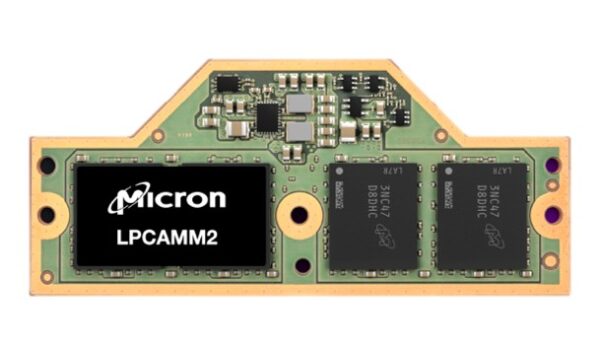
A new memory format called LPCAMM2 is set to boost efficiency and performance for PCs while enabling users to more easily upgrade their memory modules in compact laptops and desktop PCs.
Now an official specification for memory modules, LPCAMM2 can be expected in new PCs this year, with Micron Technology declaring earlier this month that it’s ready to ship modules offering 16GB, 32GB and 64GB now.
The first advantage that LPCAMM2 offers over existing portable memory modules in the familiar SODIMM format is its smaller size, said to offer up to 64 per cent in space savings.
For high-performance gaming laptops, this means PC makers can use the new modules to free up space for larger batteries or simply make a sleeker, more compact machine.
LPCAMM2 also benefits thin-and-light laptops, which typically have their memory modules soldered onto the motherboards to retain a slim design. However, this means users can’t easily upgrade the memory.
An LPCAMM2 module can be replaced by removing three screws that hold it to a motherboard. This means compact laptops can now feature memory modules that users can upgrade themselves, which will be handy since PCs now last longer than before.
Of course, all this cannot come at a discount to performance. According to Micron, which briefed Asia-Pacific reporters on this last week, LPCAMM2 offers higher performance – up to 71 per cent on the PCMark 10 benchmark test – over existing DDR5 SODIMM memory modules.
Plus, it consumes 57 to 61 per cent less active power and up to 80 per cent less system standby power than DDR5 SODIMM, claims Micron.
The chipmaker expects LPCAMM2 to be used in not just consumers PCs but also data centre machines and embedded systems deployed commercially.
This is not to say the current SODIMM format will be gone. It is expected to be around, thanks to a wide availability of capacities that PC makers can take advantage of.
And while Micron has claimed to be the first to get LPCAMM2 to market, other chipmakers like Samsung are also set to come up with theirs as well. Last year, the Korean company had shown off an earlier version of a similar module using the LPCAMM format.
Despite its improvements, LPCAMM2 is arriving at a time when chipmakers, such as Intel, AMD and Apple, are seeking to place system memory right on their CPUs, to boost performance.
This will take away any bottlenecks needed to transfer data between the two key components in a PC. In other words, no need for external memory modules that could add latency, at least on paper.
It would be interesting to see how more compact memory modules using the LPCAMM2 fit into this future paradigm.
Perhaps some segments of the market, such as data centres or embedded systems, would benefit from having memory packaged into a CPU because of the speed enhancement and simpler design.
However, just like graphics processing units (GPUs), there seems to be always a market for discrete or add-on units. While CPUs today already integrate GPUs onboard these days, high-performance and upgradable graphics cards are still very much sought after.






